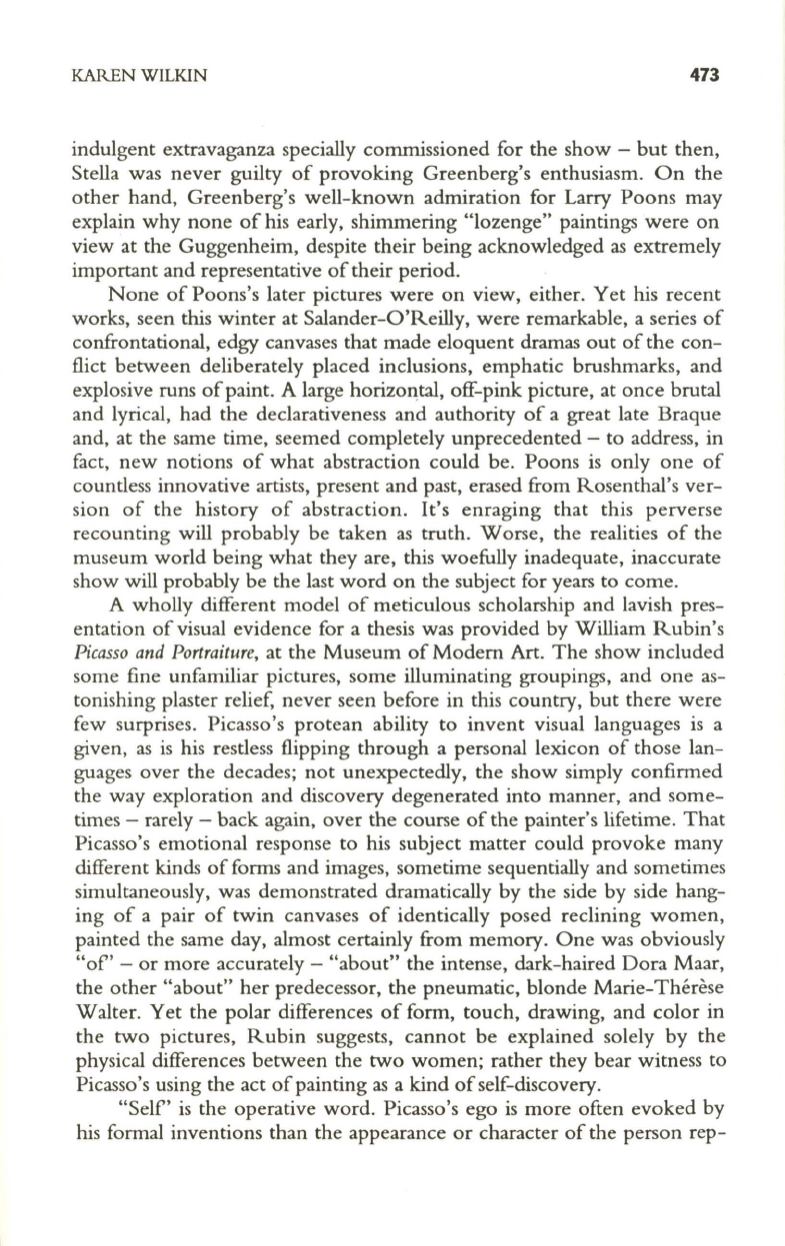
KAREN WILKIN
473
indulgent extravaganza specially commissioned for the show - but then,
Stella was never guilty of provoking Greenberg's enthusiasm. On the
other hand, Greenberg's well-known admiration for Larry Poons may
explain why none of his early, shimmering "lozenge" paintings were on
view at the Guggenheim, despite their being acknowledged as extremely
important and representative of their period.
None of Poons's later pictures were on view, either. Yet his recent
works, seen this winter at Salander-O'Reilly, were remarkable, a series of
confrontational, edgy canvases that made eloquent dramas out of the con–
flict between deliberately placed inclusions, emphatic brushmarks, and
explosive runs of paint. A large horizontal, off-pink picture, at once brutal
and lyrical, had the declarativeness and authority of a great late Braque
and, at the same time, seemed completely unprecedented - to address, in
fact, new notions of what abstraction could be. Poons is only one of
coundess innovative artists, present and past, erased from Rosenthal's ver–
sion of the history of abstraction. It's enraging that this perverse
recounting will probably be taken as truth. Worse, the realities of the
museum world being what they are, this woefully inadequate, inaccurate
show will probably be the last word on the subject for years to come.
A wholly different model of meticulous scholarship and lavish pres–
entation of visual evidence for a thesis was provided by William Rubin's
Picasso and Portraiture,
at the Museum of Modem Art. The show included
some fine unfamiliar pictures, some illuminating groupings, and one as–
tonishing plaster relief, never seen before in this country, but there were
few surprises. Picasso's protean ability to invent visual languages is a
given, as is his resdess flipping through a personal lexicon of those lan–
guages over the decades; not unexpectedly, the show simply confirmed
the way exploration and discovery degenerated into manner, and some–
times - rarely - back again, over the course of the painter's lifetime. That
Picasso's emotional response to his subject matter could provoke many
different kinds of forms and images, sometime sequentially and sometimes
simultaneously, was demonstrated dramatically by the side by side hang–
ing of a pair of twin canvases of identically posed reclining women,
painted the same day, almost certainly from memory. One was obviously
"of' - or more accurately - "about" the intense, dark-haired Dora Maar,
the other "about" her predecessor, the pneumatic, blonde Marie-Therese
Walter. Yet the polar differences of form, touch, drawing, and color in
the two pictures, Rubin suggests, cannot be explained solely by the
physical differences between the two women; rather they bear witness to
Picasso's using the act of painting as a kind of self-discovery.
"Self' is the operative word. Picasso's ego is more often evoked by
his formal inventions than the appearance or character of the person rep-


